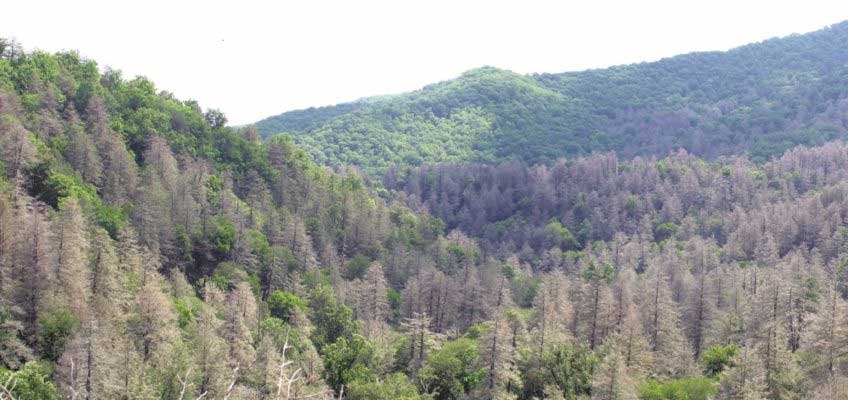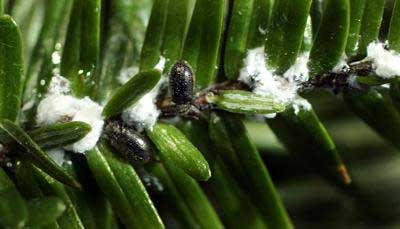By Mary Claire McCarthy
“Growing up at summer camp in Pisgah Forest, I remember using hemlock needles to make our fires. They were a central part of the landscape and of my childhood,” says Hemlock Restoration Initiative Director Margot Wallston. This is just one of the reasons why she and many others throughout the state are working to protect these trees.
When you drive through Western North Carolina, you see mountains filled with dense, lush hemlock trees. Hemlocks are some of the largest and most common trees in North Carolina, with some growing more than 150 feet tall with trunks measuring six feet in diameter. These long-lived beauties are as old as 600 years. This is changing, though. And not for the better.
Hemlocks Under Threat
An invasive insect now threatens the “redwood of the East.” The invasive hemlock woolly adelgid (HWA), an aphid-like insect, traveled from its native Asia to our shores, where it lacks a natural predator. It was first detected in the eastern U.S. in the early 1950s in Virginia and spread throughout the entire range of hemlocks from Maine to Georgia, decimating the Blue Ridge Mountains. The HWA was first discovered in western North Carolina in 1995 and has killed thousands of eastern and Carolina hemlock trees. On a broader scale, millions of hemlocks have already died; many of these towering trees now stand as ‘gray ghosts’ across mountain terrains. Hemlocks serve as more than natural beauty and nostalgia for childhood summer camp. They’re a vital factor in their environments, as well. Hemlocks are a keystone species, and as such, play a significant and incredibly important role in their environment.

Wallston explains that, “They are the architecture around which others things are built and arranged.” Their expansive shade along river banks maintains cool micro-climates critical to survival of important species like the eastern brook and brown trout and other cold-water species. These trees also maintain water quality and quantity for headwater streams, which is especially important in the winter when other trees rest dormant. Furthermore, hemlock canopy offers habitat and foraging sites for many birds that live year-round and migrate through.
The native evergreen also offers habitat for deer and bears, fights soil erosion by keeping stream banks in place, impacts the nutrient cycle and is associated with more than 100 other vertebrates. Hemlocks are a crucial element of eastern U.S. forests. Once gone, irreversible effects will reverberate throughout our ecosystems and the natural environment. For Wallston explains, “there is no tree, either native or non-native, to fill that niche.”
North Carolina is home to two type of hemlocks: the Eastern Hemlock (Tsuga canadensis) and Carolina Hemlock (Tsuga caroliniana). Eastern hemlocks dominate throughout most eastern U.S., while roughly 80% of Carolina hemlocks reside in western N.C. and a smidge of Virginia. HWA has made quick work of both. According to the Hemlock Restoration Initiative (HRI), a hub for hemlock-related activities in North Carolina, HWA is established in approximately half of the range of eastern hemlock and the entire range of Carolina hemlock.
Since its arrival, the HWA has wreaked havoc on parts of New England and the Mid-Atlantic States preying on eastern hemlock. It attacks Carolina hemlock in the south as well.
These insects appear as tiny balls of white fluff. This is because it covers itself with a white, waxy “wool” that acts as a protective coating. This coat is also where the eggs are laid. You’ll see infestations clearly at the base of hemlock needles. It feeds on trees’ sap, disrupting nutrient flow and causing needle fall off. The tree then slowly starves to death, typically within three to five years of the initial attack. While many trees have been affected, there are some ways to treat infested trees.
Pesticides are the only completely reliable way to save hemlocks from HWA infestations. With that being said, this is cost prohibitive in the long term. Biopesticides, solutions produced from fungicides and bacteria, were a possible solution but have proven ineffective because HWA’s wool blocks the biopesticide.
Biocontrols Offer a Possible Solution

One of the most promising and exciting studies revolves around biological controls, or HWA predator rearing programs. The NC Policy Collaboratory funds environmental research across the state and recently partnered with the North Carolina Department of Agriculture and Consumer Services (NCDA&CS) Beneficial Insect Laboratory, Western Carolina University, and HRI to fine-tune implementing biological control strategies to combat the HWA.
Research shows that two toothed fungus beetles, Laricobius osakensis and L. nigrinus, are some of the best biological control insects. These beetles are a species native to Japan, the Derodontid beetle.
Wallston says that Laricobius is “more reliable to recover than past beetles.” According to NCDA&CS’s Biological Control Administrator, Steven P. Turner, once brought to a site, these beetles establish themselves quickly, meaning they survive, reproduce and disperse well, and show promise as an effective predator of HWA. In fact, Laricobius need HWA almost as much as we need it. Laricobius osakensis and L. nigrinus can’t survive off of artificial diet, so the HRI and BI Laboratory collects infested hemlock branches to feed the beetles at the lab.
Currently, no natural, native predators exist for the HWA in the eastern United States. But by introducing a predator, state officials hope to create an ecological balance, which is the underlying goal of the HWA predator rearing program. This study will create a baseline understanding of the best way to deploy the biocontrols.
The project began in 2018 by releasing beetle eggs at Pinnacle Park. The beetles go through a process similar to butterflies, so they won’t come out of the ground until this fall. In the meantime, they will complete their life cycle and eat some HWA along the way. The Laricobius adult females begin by laying their eggs in the ovisacs, or egg sacs, of the HWA in order to provide food for their larvae. Once the larvae hatch, they’ll eat the HWA eggs and crawlers before dropping to the ground to pupate. The biocontrol program oviposits Laricobius eggs in the lab, meaning the adult females lay their eggs. Before they hatch, the eggs are moved onto hemlocks in the field, where the rest of their life cycle will take place.
Raising Beetles in the Lab
Once these beetles finish their life cycle, the researchers will analyze this method’s success by monitoring the survival rate of the beetles that emerge. Turner says, “It would save money, certainly refine the process and basically make it easier for us to get more biocontrols out there to people that need them.” The typical alternative is rearing the beetles until adulthood in the lab and then releasing the next generation onto trees in the field.
The lab method requires more resources and time, so if the results from this stage of the study are positive, the entire process could be streamlined. If the beetles survive from the egg or larvae stage in the field, then many more people can get access to them throughout the state. Turner explains that one of the biggest problems of rearing beetles in the lab is mortality. It can vary from 50% – 70% from the pupal stage to the adult emergence phase. Turner explains that, “This is why we’re looking at a side project in the lab with different incubation temperatures and humidity and different substrate consistencies.”
Since last spring, Turner, has nurtured over 2100 Laricobius osakensis and L. nigrinus into adulthood at the Biological Control Lab. An estimated 5,000 will be alive at the end of the season!

This winter, Turner will work with the Executive Director at Highlands Biological Station, James T. Costa, Western North Carolina Associate Professor of Natural Resource Conservation and Management , Peter Bates and HRI to release the adult beetles at new selected sites. In this emergent program, beetles will be released in Western N.C. in Jackson and Macon counties on NCDA&CS Plant Conservation Program lands.
“When they are healthy, there is nothing quite like a hemlock in the forest, its lush green foliage coming all the way to the ground. As one of the longest lived and largest trees in the eastern US, they command our respect with their ancient stateliness,” says Wallston.
Hemlocks are crucial to our landscape for both humans and the ecosystems they bolster, which is why it’s so important to protect them. Many restoration efforts are under way though, and there are many ways you can get involved. Head over to the Hemlock Restoration Initiative’s website to learn about different volunteer opportunities. Then in the spring, check back in with NC Policy Collaboratory to see how the beetles are doing!
Mary Claire McCarthy is a graduate student at the UNC-Chapel Hill Hussman School of Journalism and Media. She is working as a Communications Intern with the NC Policy Collaboratory this semester.
